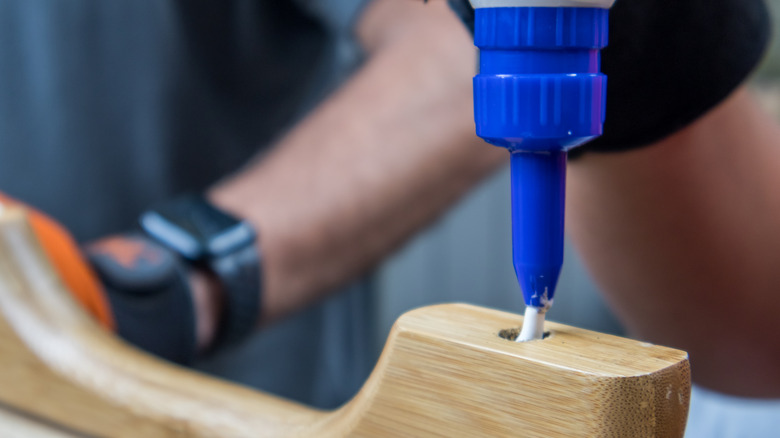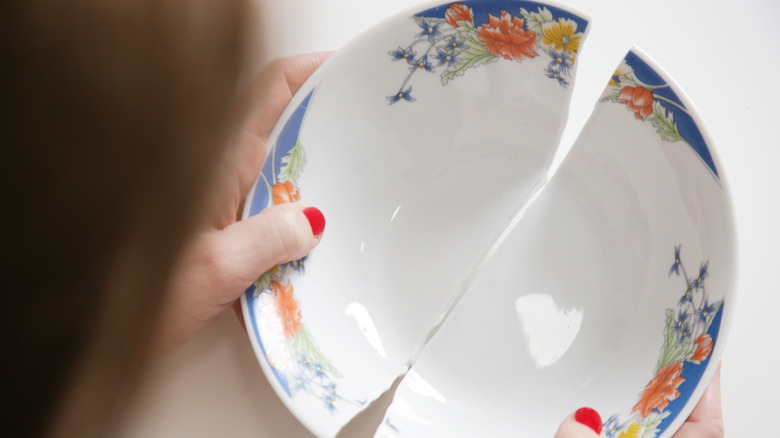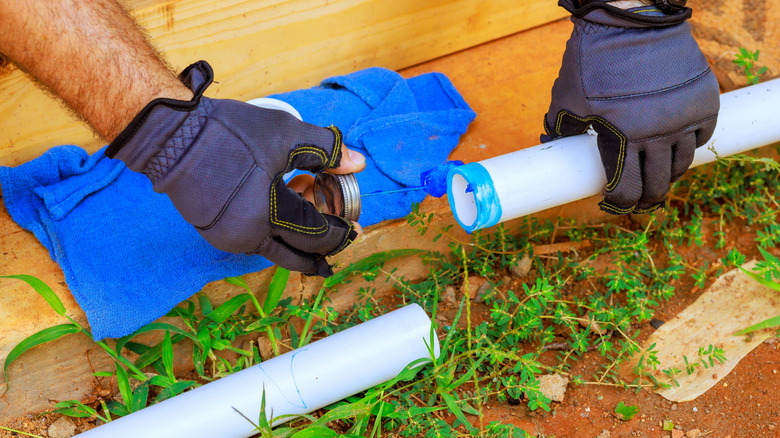You're Using The Wrong Glue For These Materials (& What You Should Use Instead)
We may receive a commission on purchases made from links.
Gluing two things together is such a simple concept, but if you are using the wrong glue, it can be a disaster. Selecting the correct glue for each material (or for gluing blended materials, say, glass to metal) can actually be fairly complicated. But there are broad categories of glues and materials which will help you select the proper adhesive for the job. For instance? Wood requires a special type of glue.
People have been gluing wood together for centuries. What is commonly called yellow glue (or carpenter's glue) is the most popular and versatile wood glue available. It's water resistant and, in some formulas, nearly waterproof. Polyvinyl acetate, commonly called white glue, isn't the most common choice in professional shops, but remains a tried-and-true option that can produce excellent results. Polyurethane glues (such as Gorilla Glue) also produce excellent wood-to-wood bonds that are highly water resistant, but they have one downside: once opened, the glue hardens in the bottle quickly.
Epoxy is a two-part resin-based adhesive that is waterproof and extremely strong, but much more expensive than the other glues. The glue comes in different formulas. If you use it with wood, select a formula that takes the longest time to cure — it will produce the strongest bond. An ancient wood glue known as hide glue is well liked among instrument makers and fine furniture folks, and has the advantage of being removable in hot water. Not good for a boat, but fine for a chest of drawers.
Ceramics and glass
Ceramics and glass are a materials that confuse some people when it comes to glue. Ceramics and pottery are not technically the same thing, but for gluing purposes, they are close enough. Made from clay that has been heated to a temperature between about 660 and 1,470 degrees Fahrenheit, pottery becomes very strong and remarkably durable. But, it's still brittle enough that it is not uncommon for it to break or fracture. There are two main recommended glues for ceramic repair: the aforementioned epoxy and cyanoacrylate adhesive. Cyanoacrylate adhesive or CA glue — you may know it better as super glue — comes in many formulations, including this one specifically designed for ceramics.
Gluing glass together and to other materials requires specific adhesives. Our old buddy epoxy is in the mix again and works very well. Ultraviolet (UV) curing acrylic resins are oddly magical and great for clear glass. The resin is cured by UV light, sunlight or a UV lamp will do the trick. The glass pieces need to fit very tightly together for this product but with clear glass it is nearly invisible. Most of us have seen an aquarium made with metal or wooden frames. The glues in that sort of construction are silicone based. Silicone glues are a solution to glue glass to wood and other materials like plastic. Not only that, but you can use it to glue glass to metal as well. These types of glue take a long time to cure and can release strong fumes, so use cautiously.
Plastics and metals
Gluing metal to metal is possible if you can't use fasteners like screws and bolts, which are stronger when done properly. The three main adhesives to use when bonding metal are CA glue, polyurethane glue, and epoxy. With properly cleaned and prepared surfaces, epoxy provides the strongest bond, with polyurethane glue and CA glue following in that order. If you are securing a sheet of aluminum, brass, or steel to plywood substrate to make a work surface, contact adhesive is your best product.
Plastics are a challenge because there are so many kinds. But you can do some sleuthing to figure out which adhesive works with your plastic. Locate the recycling category of the plastic you are using. Near the triangular recycling mark, you may find a number. Those numbers align with types of plastic, and can be glued with specific products.
Polyethylenes and polypropylenes, which will have a recycling number of 1, 2, 4, or 5, are tricky and need a specialty product like Scotch-Weld DP8010. Additionally, polyvinyl chloride or PVC in pipes are type 3 and have their own special solvent glue that bonds pieces. For polystyrenes or type 6, use a two-part non-yellowing epoxy with a quick cure time. Plastics with the number 7 (such as BPA, polycarbonate and LEXAN) will probably work with epoxy or a CA glue. Hard plastic pieces like Legos and plastic model parts are best glued with super plastic glue. When in doubt, try epoxy or CA glue and hope for the best.


